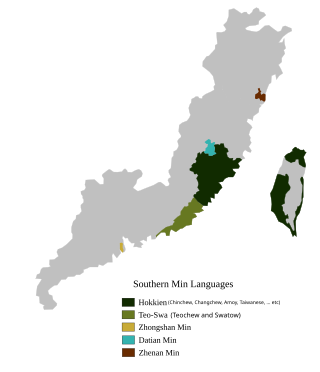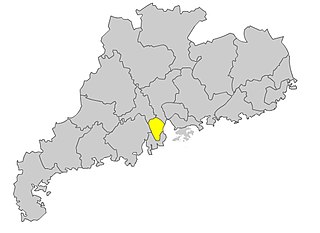Manjiang, also known as Manhua, is an Eastern Min dialect spoken mainly in Taishun and Cangnan Counties in Wenzhou, as well as parts of Qingyuan County in Lishui, in southeastern Zhejiang province.

Eastern Min or Min Dong is a branch of the Min group of the Chinese languages of China. The prestige form and most commonly cited representative form is the Fuzhou dialect, the speech of the capital of Fujian.

Central Min, or Min Zhong, is a part of the Min group of varieties of Chinese. It is spoken in the valley of the Sha River in Sanming prefecture in the central mountain areas of Fujian, consisting of Yong'an, the urban area of Sanming and Sha County.

Leizhou or LuichewMin is a branch of Min Chinese spoken in Leizhou city, Xuwen County, Mazhang District, most parts of Suixi County and also spoken inside of the linguistically diverse Xiashan District. In the classification of Yuan Jiahua, it was included in the Southern Min group, though it has low intelligibility with other Southern Min varieties. In the classification of Li Rong, used by the Language Atlas of China, it was treated as a separate Min subgroup. Hou Jingyi combined it with Hainanese in a Qiong–Lei group.

Hailufeng, or in the language itself Haklau, is a variety of Chinese mostly spoken in the Hailufeng region of Guangdong. The region includes Shanwei (Swabue), which administratively includes Haifeng County, and Lufeng City, which itself was a former county and now county-level city. The name 'Hailufeng' / 'Hai Lok Hong' (海陸丰) is a portmanteau of those places. It is a Southern Min language with similarities to Hokkien, especially Chiangchew Hokkien, though it also has close geographical and cultural ties with neighboring Teochew. Ethnically, the Haklau see themselves as Hokkiens, separate from the Teochews.

Shao–Jiang or Shaojiang Min is a Min Chinese language centered on Western Nanping in Northwest Fujian, specifically in the Nanping counties of Guangze, Shaowu, and Western Shunchang and the Northern Sanming county of Jiangle.

The Longdu dialect is a variety of the Eastern Min branch of Chinese originating from the towns of Dachong and Shaxi in Zhongshan in the Pearl River Delta of Guangdong. The two regions Shaxi and Dachong are together informally known as the Longdu region to locals and those overseas. There are more than 40 villages in the region and are held together by their shared dialect, which may be classified as endangered due to its deterioration in status and rapidly decreasing popularity even within the Longdu region. Despite its close proximity, the Longdu dialect is not very closely related to the surrounding dialects in the region, which belong to the Yue group. As such, Longdu forms a "dialect island" of Min speakers. It is one of three enclaves of Min in Zhongshan, the others being Sanxiang and Nanlang.
Zhongshan Min, known as Cunhua by its speakers, are three Min Chinese dialect islands in the Zhongshan region of the southern Chinese province of Guangdong. The Zhongshan Min people settled in the region from Fujian Province as early as the Northern Song dynasty period (1023–1031). The three dialects are:

Zhenan Min, is a Min Nan Chinese language spoken in the vicinity of Wenzhou, in the southeast of Zhejiang province.

The Longyan dialect, also known as Longyan Minnan or Liong11l11334, is a dialect of Hokkien spoken in the urban city area of Longyan in the province of Fujian, China while Hakka is spoken in rural villages of Longyan. The Longyan Min people had settled in the region from southern part of Fujian Province as early as the Tang dynasty period (618–907). Although Longyan Min has some Hakka influence to a limited extent by the peasant Hakka Chinese language due to close distance of rural village Hakka peasants of the region, Longyan Min is a close dialect of the Minnan language and has more number of tones than Hakka. The Longyan dialect has a high but limited intelligibility with Southern Min dialects such as Hokkien–Taiwanese. Today, Longyan Minnan is predominantly spoken in Longyan's urban district Xinluo District while Zhangzhou Minnan is spoken in Zhangping City excluding Chishui and Shuangyang towns where Longyan Minnan is spoken. Hakka on the other hand is spoken in the non-urban rest of the rural areas of Longyan prefecture: Changting County, Liancheng County, Shanghang County, Wuping County, and Yongding District.

The Zhanjiang dialect is a dialect mostly spoken in Zhanjiang in Guangdong, China. It is a sub-dialect of Leizhou Min.

Sanxiang is a variety of Eastern Min Chinese mostly spoken in Sanxiang in Zhongshan in the Pearl River Delta of Guangdong, China. Despite its close proximity, Sanxiang is not very closely related to the surrounding dialects in the region, which belong to the Yue group, and thus forms a "dialect island" of Min speakers. It is one of three enclaves of Min in Zhongshan, the others being Longdu and Nanlang.
Jianyang (Kienyang) is a dialect of Northern Min Chinese spoken in Jianyang in the north of Fujian province.
The Fu'an dialect (福安話) is a dialect of Eastern Min, which is a branch of Min Chinese spoken mainly in the eastern part of Fujian Province, China.
The Putian dialect is a dialect of Pu-Xian Min Chinese spoken in urban area of Putian, which is a prefecture-level city in the southeast coast of Fujian province.
Shaxian dialect is a dialect of Central Min Chinese spoken in Sha County, Sanming in Western Fujian Province of China.
The Haikou dialect is a topolect of Chinese and a subvariety of Hainanese spoken in Haikou, the capital of the Hainan province and island of China.
The Wenchang dialect is a dialect of Hainanese spoken in Wenchang, a county-level city in the northeast of Hainan, an island province in southern China.

The Matsu dialect is the local dialect of Matsu Islands, Taiwan. Native speakers also call it Bàng-huâ (平話), meaning the language spoken in everyday life. It is recognised as one of the statutory languages for public transport announcements in Lienchiang County, Taiwan.
The Yongchun dialect is a dialect of the Hokkien language mostly spoken in Yongchun County of Quanzhou city in Southern Fujian Province, China. It belongs to the Quanzhou Hokkien branch.








